22.04.2561 Naypyidaw หรือ Nay Pyi Taw ( Kyetpyay, Pyinmana or Kyatpyay, Pyinmana) is the capital city of Myanmar.
Naypyidaw
[hide]This article has multiple issues. Please help improve it or discuss these issues on the talk page. (Learn how and when to remove these template messages)
|
Naypyidaw, officially spelled Nay Pyi Taw (Burmese: နေပြည်တော်; MLCTS: Nepranytau, sometimes also Naypyitaw; pronounced [nèpjìdɔ̀], formerly known as Kyetpyay, Pyinmana or Kyatpyay, Pyinmana), is the capital city of Myanmar. It is administered as the Naypyidaw Union Territory, as per the Constitution.[2]
On 6 November 2005, the administrative capital of the country was quietly relocated from Yangon to a greenfield site about 320 km (200 mi) north of where it had been, with minimal explanation from the government.[5] The new capital's official name was made public on 27 March 2006, Myanmar's Armed Forces Day. Construction of this planned city began in 2002 and was completed by 2012.[6] Naypyidaw is notable for its unusual combination of large size and very low population density.[7] The city hosted the 24th and 25th ASEAN Summit, the Ninth East Asia Summit, and the 2013 Southeast Asian Games.
Contents
[hide]Etymology[edit]
Naypyidaw is Burmese for "abode of the king", and is generally translated as "royal capital,"[8] "seat of the king," or "abode of kings."[4] Traditionally, it was used as a suffix to the names of royal capitals, such as Mandalay, which was called Yadanabon Naypyidaw (ရတနာပုံနေပြည်တော်).
History[edit]
Naypyidaw has a short history. It was founded on a greenfield site near Pyinmana, about 320 kilometres (200 mi) north of the old capital, Yangon. Construction started in 2002.[4] At least 25 construction companies were hired by the military government to build the city, including Asia World and Htoo Ltd.[9] The military government began moving government ministries from Yangon to Naypyidaw on 6 November 2005 at the astrologically auspicious time of 6:37 a.m.[10] Five days later, on 11 November at 11 a.m., a second convoy of 1,100 military trucks carrying 11 military battalions and 11 government ministries left Yangon. The ministries were expected to be mostly in place by the end of February 2006; however, the hasty move led to a lack of schools and other amenities which separated the government employees from their families for the time being. The government originally prohibited families of government workers from moving to the new capital.[11] Military headquarters were located in a separate compound from the government ministries, and civilians have been banned from entering either. Vendors are restricted to a commercial zone near the government offices.
On 27 March 2006, more than 12,000 troops marched in the new capital in its first public event: a massive military parade to mark Armed Forces Day—which is the anniversary of then Burma's 1945 uprising against the Japanese occupation of Burma. Filming was restricted to the concrete parade ground which contains three enormous sculptures—depictions of the Burmese kings Anawrahta, Bayinnaung and Alaungpaya, who are considered the three most important kings in Burmese history. The city was officially named Naypyidaw during these ceremonies.[12]
Rationale for moving the capital[edit]
It is not known why the capital was moved, but according to The Guardian, it was because Than Shwe did it as a "vanity project."[13] Naypyidaw is more centrally located than the old capital, Yangon. It is also a transportation hub located adjacent to the Shan, Kayah, and Kayin states. It was felt by governmental and military leaders that a stronger military and governmental presence nearby might provide stability to those chronically turbulent regions.[14] The official explanation for moving the capital was that Yangon had become too congested and crowded with little room for future expansion of government offices.[4] After the move, Yangon was severely impacted by a devastating cyclone in 2008, being located in a river delta near the coast. It is prone to changing weather patterns.
Some Western diplomats[who?] speculated that the government was concerned with the possibility of foreign attack, as Yangon is on the coast and therefore vulnerable to an amphibious invasion.[15][16] The popular belief among the Burmese is that a warning about foreign attack was delivered to the military chief by an astrologer.[17] Indian journalist Siddharth Varadarajan, who visited Naypyidaw in January 2007, wrote that the military government built the city to protect its hold on power, noting the fact that it has no city center or any confined public space where a crowd of thousands of people could make a political impression, and its location meant that the military government would be unaffected if Yangon, the country's previous capital and largest city, home to a tenth of the country's population, was brought to a standstill by political demonstrations. He described the vastness of the new capital as "the ultimate insurance against regime change, a masterpiece of urban planning designed to defeat any putative 'colour revolution'—not by tanks and water cannons, but by geometry and cartography".[18]
Geography and climate[edit]
Naypyidaw is located between the Bago Yoma and Shan Yoma mountain ranges. The city covers an area of 7,054.37 km2 (2,723.71 sq mi) and has a population of 924,608, according to official figures.[19]
Chaungmagyi Dam is located a few kilometers to the north of Naypyidaw, while Ngalaik Dam is a few kilometers to the south. The Yezin Dam is farther away in the north-east.
| [show]Climate data for Naypyidaw |
|---|
Cityscape[edit]
Naypyidaw is organized into a number of zones. As of 2013, the city is still lacking many of the facilities one would expect in a capital city.
Residential zones[edit]
The residential areas are carefully organized, and apartments are allotted according to rank and marital status.[20] The city currently has 1,200 four-story apartment blocks.[21] The roofs of apartment buildings are color-coded by the jobs of their residents; Ministry of Health employees live in buildings with blue roofs and Ministry of Agriculture employees live in those with green roofs.[20] High-ranking government officials live in mansions,[22] of which there are about 50. Many of the city's residents, however, live in slums.[23]
Military zones[edit]
High-ranking military officers and other key officials live 11 km (6.8 mi) away from regular government employees in a complex said to consist of tunnels and bunkers; this area is restricted to the public.[20] The city also hosts a military base, which is inaccessible to citizens or other personnel without written permission.[6] Inside the military zone, the roads have eight lanes to allow small aircraft to land.
Ministry zone[edit]
The city's Ministry zone contains the headquarters of Myanmar's government ministries. All the ministry buildings are identical in appearance.[24] A parliamentarycomplex consisting of 31 buildings[25] and a 100-room presidential palace are also located there.[20] The zone also contains the city hall building, which has many characteristics of Stalinist architecture, but with a Burmese-style roof.
Hotel zone[edit]
The Hotel zone has a handful of villa-style hotels on the hilly outskirts of the city. There are currently twelve hotels located in or near Naypyidaw. Eight of these are located within the Naypyidaw Hotel Zone, and two are located in Laeway (Lewe) on the Yangon-Mandalay Road.[26] Forty villas were constructed near the Myanmar Convention Centre in preparation for the 25th ASEAN summit conducted in Naypyidaw in November 2014. Construction of the villas was begun in 2010 by the government. However funds were limited so the project was later put out to tender for completion by private sector investors. Details of the tender process are unclear but ten companies were chosen to participate in the activity including firms owned by prominent business people known to have close connections with the government.[27]
348 hotels and 442 inns were constructed to house the athletes and spectators of the 2013 Southeast Asian Games, which was hosted in Naypyidaw.[28]
Shopping[edit]
Naypyitaw Myoma Market is currently the commercial centre of Naypyidaw.
Other shopping areas include Thapye Chaung Market and Junction Centre Naypyidaw. Built by the Shwe Taung Development company and completed in August 2009, Junction Centre is the capital's first privately operated shopping centre.[19] There are also local markets and a restaurant area.
Recreation[edit]
Ngalaik Lake Gardens is a small water park situated along the Ngalaik Dam, near Kyweshin Village on Ngalaik Lake (about 11 kilometres (7 mi) from Naypyidaw). Opened in 2008, facilities at the Ngalaik Lake Gardens include water slides, natural resorts, lodging and a beach. The gardens are open to the public during Thingyan holidays.[29]
Also opened in 2008, the 81-hectare (200-acre) National Herbal Park has exhibits of plants having medicinal applications from all of the major regions of Myanmar. There are thousands of plants at the park, representing hundreds of different species.[30]
Behind the city hall, there is a park with a playground and water fountain complex, which hosts a musical light show every night.[20]
The Naypyidaw Zoological Gardens opened in 2008 with 420 species and now with 1500 animals. The main attraction of the zoo is the climate-controlled penguin house. The zoo is larger than the one in Yangon.[31][32] The Naypyidaw Safari Park officially opened on 12 February 2011.[33][34]
Naypyidaw also has two golf courses (Nay Pyi Taw City Golf Course and Yaypyar Golf Course) and a gem museum.[26]
Uppatasanti Pagoda[edit]
Similar in size and shape to the Shwedagon Pagoda in Yangon, Uppatasanti Pagoda was completed in 2009.[35] This new pagoda is named the Uppatasanti or "Peace Pagoda". The stake-driving ceremony for the pagoda was held on 12 November 2006.[36] The invitation card for the ceremony opened with a phrase "Rajahtani Naypyidaw (the royal capital where the king resides)".[37] The pagoda is just 30 cm (12 in) shorter than the Shwedagon Pagoda.[38] Uppatasanti translates roughly to "Protection against Calamity". It is the name of a sūtra prepared by a monk in the early 16th century. It is to be recited in time of crisis, especially in the face of foreign invasion.[39]
International zone[edit]
The government has set aside 2 hectares (4.9 acres) of land each for foreign embassies and headquarters of United Nations missions. Rumors to the contrary, while the Bangladeshi embassy has secured land for a new embassy and begun design work for facilities, no construction has begun and the embassy remains in Yangon.
Culture[edit]
Entertainment[edit]
The Myanmar Motion Picture Academy Awards are held annually in Naypyidaw given to the highest achievers in Burmese cinema.[40] There is a movie theater in the Junction Centre Mall in Naypyidaw. There are two others in nearby Pyinmana, and one in Tatkone Township.[26]
Administration[edit]
Naypyitaw is a Union Territory under the direct administration of the President. Day-to-day functions are carried out on the President's behalf by the Naypyidaw Council led by a Chairperson. The Chairperson and members of the Naypyitaw Council are appointed by the President and include both civilians and Armed Forces representatives.[41]
On 30 March 2011, President Thein Sein appointed Thein Nyunt as chairman of the Naypyitaw Council, along with 9 chair members: Than Htay, Colonel Myint Aung Than, Kan Chun, Paing Soe, Saw Hla, Myint Swe, Myint Shwe and Myo Nyunt.[42]
The Naypyitaw Union Territory consists of the city proper (downtown) and eight surrounding townships.[19] Downtown is further divided into four wards. Pyinmana, Lewe, and Tatkone townships were all formerly part of Yamethin District. Oathara Thiri, Dekkina Thiri, Poppha Thiri, Zapu Thiri, and Zeyar Thiri are all new townships currently under construction. As of December 2009, most government ministry offices have been relocated to the administrative capital. Only the offices of ministries' directorates remain in Yangon.[19]
- City proper (Wards)
- Zeyatheiddhi (ဇေယျသိဒ္ဓိ ရပ်ကွက်, from Pali jeyyasiddi)
- Pyinnyatheddhi (ပညာသိဒ္ဓိ ရပ်ကွက်, from Pali pañasiddi)
- Bawgatheiddhi (ဘောဂသိဒ္ဓိ ရပ်ကွက်, from Pali bhogasiddi)
- Mingalatheiddhi (မင်္ဂလာသိဒ္ဓိ ရပ်ကွက်, from Pali mangalasiddi)
- Pre-existing townships
- New Townships
- Ottarathiri Township (ဥတ္တရသီရိ မြို့နယ်, from Pali uttarasiri)
- Dekkhinathiri Township (ဒက္ခိဏသီရိ မြို့နယ်, from Pali dakkhinasiri)
- Pobbathiri Township (ပုဗ္ဗသီရိ မြို့နယ်, from Pali pubbasiri)
- Zabuthiri Township (ဇမ္ဗူသီရိ မြို့နယ်, from Pali jambusiri)
- Zeyarthiri Township (ဇေယျာသီရိ မြို့နယ်, from Pali jeyyasiri)
There is sometimes some controversy about land use and changes in land ownership related to the urban spread of Naypyitaw. In late 2014, for example, there were suggestions in parliament that land grabs were occurring near the Dekkhinathiri Township and that existing laws needed to be amended to provide better protection for farmers.[43] There has also been criticism from some members of parliament about the size of the Naypyitaw Union Territory and the fact that money is being spent on urban infrastructure (such as lighting around lakes) although the facilities do not attract much use.[44]
Education and research[edit]
Basic Education[edit]
- No. 1 Basic Education High School
- No. 2 Basic Education High School
Higher Education[edit]
Yezin (a few kilometers north-east of Naypyidaw and Pyinmana)
Research[edit]
- Southeast Asia Biodiversity Research Institute (SABRI)[45]
Transportation[edit]
Public transport services are limited between neighborhoods.[20] The four-lane, 323.2 km (200.8 mi) Yangon-Naypyidaw highway links Naypyidaw with Yangon directly and is part of the 563 km (350 mi)-long overall Yangon-Naypyidaw-Mandalay Expressway. There is a 20-lane boulevard; like most roads in the city, it is largely empty.[46]
Metro system[edit]
In August 2011, Russian news media announced that a Russian-based firm would be constructing a 50-kilometre (31 mi) metro line, which would be the country's first underground rail system, underneath Naypyidaw.[47][48] However, the Rail Transportation Ministry then announced that the plan had been cancelled due to lack of demand and budgetary limits.[49]
Buses and cars[edit]
Naypyidaw has four-lane roads and multilevel, flower-covered roundabouts (traffic circles[50]). Government ministries run shuttle buses in the morning and evening to their respective buildings.[51]
Motorbikes are banned from some roads in Naypyidaw city limits, including sections of Taw Win Yadana Road, as a result of hundreds of traffic accident-related deaths in 2009.[52]
Rail[edit]
Naypyidaw railway station (published as Nay Pyi Taw railway station) was opened at milepost No. (233/0), between Ywataw station and Kyihtaunggan station on the Yangon-Mandalay railroad with a station area of 2,700 m × 1,200 m (9,000 ft × 4,000 ft) and a covered area of 334.5 hectares (826.5 acres). Construction began on 8 December 2006 and Naypyidaw railway station was opened on 5 July 2009, even though the overpass, locomotive shed, concrete road leading up to the station, parking lot, passenger lounge and platform were not completed.[53]
Myanmar Railways has announced that passengers traveling on all trains except mail and local ones are to get off only at Nay Pyi Taw Station as they will not stop at Pyinmana Station after the inauguration of Nay Pyi Taw Station.[54]
Before the opening of Naypyidaw railway station, Naypyidaw was served by Pyinmana and Lewe stations, though only Pyinmana station is on the main rail line (which extends from Yangon-Bago-Naypyidaw-Thazi-Mandalay). Lewe station is on the way from Pyinmana to Kyaukpadaung. It takes nine hours by train to get from Yangon to Pyinmana; trains leave at 12:00 and arrive at 21:30 local time.[55]
Air[edit]
Naypyidaw Airport, also known as Ayelar Airport, is 16 km (10 mi) south-east of the city, between the towns of Ela and Lewe. It is served by all domestic airlines—Air Bagan, Air Mandalay, Myanmar National Airlines, FMI Air and Yangon Airways—with regular flights to Yangon and other cities across the country.[56] Since April 2009, the airport is undergoing major expansion to handle up to 3.5 million passengers per year.[57]
Healthcare[edit]
The city is served by five public hospitals: 1000-bed Nay Pyi Taw General Hospital , Nay Pyi Taw Women Hospital, Nay Pyi Taw ENT Hospital, 100-bedded Nay Pyi Taw Traditional Medicine Hospital and Nay Pyi Taw Orthopaedic Hospital.[58][59][60][61] There is also a 300-bed Obstetric, Gynaecological and Children's Hospital of Defence Services, which is one of the teaching hospitals of Myanmar Defence Services Medical Academy. The nearby towns of Lewe, Pyinmana, and Tatkone each have one hospital.[26]
Sports[edit]
Nay Pyi Taw F.C, a Myanmar National League football club, is based at Wunna Theikdi Stadium in Nay Pyi Taw.
Main sights[edit]
Pagodas[edit]
- Uppatasanti Pagoda
- Thatta Thattaha Maha Bawdi Pagoda (replica Buddha Gaya)
Museums and memorials[edit]
- Memorial to the Fallen Heroes
- National Museum
- Defence Services Museum
- Gem Museum
- Planetarium
- The Museum of Sport[62]
Recreation[edit]
- Naypyidaw Zoological Gardens
- National Herbal Park
- Naypyidaw Safari Park
- Naypyidaw Water Fountain Garden
- Wunna Theikdi Stadium
- Wunna Theikdi Indoor Stadium
- Zayarthiri Stadium
Concert halls and theatres[edit]
- Myanmar International Convention Centre 1 (MICC-1)
- Myanmar International Convention Centre 2 (MICC-2)
- Open-Air Theatre[63]
Communications[edit]
Since 2009, Naypyidaw has had mobile phone coverage.
Media[edit]
In March 2014, Naypyidaw was one of the locations featured on the British motoring TV show Top Gear during a two-part special event in Myanmar.
Consequences[edit]
The establishment of Naypyidaw was an extraordinary project. However, the shorter-term and long-term consequences of establishing the new capital are not yet clear.
Data on the economic impact of constructing Naypyidaw are scarce but the national economic impact of the huge construction effort must have been very considerable. One estimate puts the cost in the range of $3–4 billion although only part of this estimate is for cash spending because non-cash investments were also reportedly involved in supporting the construction effort.[64] There must have been a large localised construction boom, the result of which is that a vast new economic asset has been created.[65] On the other hand, current (mid 2014) utilisation of the vast new asset is very low. Most of the remarkable main roads in the city (10 lane roadways are common) are ghost roads for much of the time. There are large areas of vacant land between many buildings.[66] The entire city has sometimes been referred to as a "ghost town".[67] Other descriptions are that Naypyidaw is 'like an enormous film set or an abandoned Disneyland without attractions'[68]
One of the consequences of administration for the nation is that there is now continual travel by vehicles along the relatively new 300 km highway from Yangon to Naypyidaw. But the highway is four lanes for most of the way. There is clearly a large amount of excess capacity because there are relatively few vehicles for much of the time on the road. Most trucks travelling north from Yangon to Naypyidaw and Mandalay are forbidden from using the highway. The Asian Development Bank has estimated that allowing more trucks onto the road would save over $100 million per year in reduced travelling time and other savings.[69]Remarkably, there are plans to turn the road into a six lane highway because it is believed that a wider road will be safer to travel on.[70] Additional lanes have already been built along some sections of the highway and in some places construction is underway to widen the bridges.
Another consequence of the isolation of the new capital is that the costs of doing business with government have increased considerably. People and organisations (such as from business, community, and international investors and organisations) must usually travel to Naypyidaw, often from Yangon, to meet with senior government officials. Since the round trip by road from Yangon to Naypyidaw takes over 10 hours, the time now spent by senior business and community leaders on travel to meet with government representatives is considerable.
See also[edit]
Image gallery[edit]
References[edit]
- Dulyapak Preecharushh, Naypyidaw: New Capital of Burma, 2009, White Lotus. ISBN 978-9744801302
Notes[edit]
- ^ Department of Population, Myanmar.
- ^ a b "တိုင်းခုနစ်တိုင်းကို တိုင်းဒေသကြီးများအဖြစ် လည်းကောင်း၊ ကိုယ်ပိုင်အုပ်ချုပ်ခွင့်ရ တိုင်းနှင့် ကိုယ်ပိုင်အုပ်ချုပ်ခွင့်ရ ဒေသများ ရုံးစိုက်ရာ မြို့များကို လည်းကောင်း ပြည်ထောင်စုနယ်မြေတွင် ခရိုင်နှင့်မြို့နယ်များကို လည်းကောင်း သတ်မှတ်ကြေညာ". Weekly Eleven News (in Burmese). 20 August 2010. Retrieved 23 August 2010.
- ^ "News Briefs". The Myanmar Times. Myanmar Consolidated Media. 20 March 2006. Archived from the original on 27 June 2006. Retrieved 1 April2006.
- ^ a b c d e Pedrosa, Veronica (20 November 2006). "Burma's 'seat of the kings'". Al Jazeera. Archived from the original on 23 November 2006. Retrieved 21 November 2006.
- ^ "Naypyidaw: Burma". Geographical Names. Retrieved 6 December 2011.
- ^ a b Marshall Cavendish Corporation (2007). World and Its Peoples: Eastern and Southern Asia. Marshall Cavendish. p. 650.
- ^ "This 'empty' city is more than four times the size of London". indy100. 21 June 2017. Retrieved 21 June 2017.
- ^ "An Introduction to the Toponymy of Burma (October 2007) – Annex A"Archived 31 October 2008 at the Wayback Machine. p. 8, The Permanent Committee on Geographic Names (PCGN), United Kingdom
- ^ "Buki Yuushuu". YouTube. Retrieved 28 June 2017.
- ^ "Moving Target". The Irrawaddy. 9 November 2005. Archived from the original on 30 September 2007. Retrieved 15 July 2007.
- ^ Ntay, Hla Hla (23 February 2007). Myanmar's new capital offers little in the way of luxuries Archived 29 June 2017 at the Wayback Machine.. Agence France-Presse.
- ^ "Burma's new capital stages parade". BBC News. 27 March 2006. Retrieved 6 April 2006.
- ^ Kennard, Matt; Provost, Claire (19 March 2015). "Burma's bizarre capital: a super-sized slice of post-apocalypse suburbia". The Guardian. Retrieved 20 March 2015.
- ^ McGeown, Kate (8 November 2005). Burma's confusing capital move. BBC News.
- ^ McGeown, Kate (17 June 2006). Burma's confusion over capital. BBC News.
- ^ Zaw, Aung (9 November 2005). Moving Target. The Irrawaddy. Archived29 May 2012 at the Wayback Machine.
- ^ "Myanmar's Ghost Capital Rises From The Jungle". 18 November 2011. Retrieved 25 December 2011.
- ^ "Naypyitaw – Dictatorship by Cartography". Himal Southasian. February 2007. Retrieved 29 August 2007.
- ^ a b c d "Construction of Myanmar new capital continues". People's Daily. Xinhua News. 24 December 2009.
- ^ a b c d e f g Living in a ghost town. Bangkok Post. 18 October 2009.
- ^ Peck, Grant (5 October 2007). "Myanmar's Remote Capital Is Still a Work in Progress". The New York Times. Retrieved 20 May 2010.
- ^ [1][dead link]
- ^ Will (15 June 2007). "The Flying Dutchman: Inside Naypyidaw". willthedutch.blogspot.com. Retrieved 28 June 2017.
- ^ The Australian. "A monument to junta's fear". 16 October 2007
- ^ "As poll looms, Myanmar still building parliament". Reuters. 17 January 2010.
- ^ a b c d Myanmar Yellow Pages: Nay Pyi Taw Listings Archived 2 March 2012 at the Wayback Machine.
- ^ 'Naw Pyi Taw's national guesthouses', Mizzima, 8 November 2014. Archived 13 November 2014 at the Wayback Machine.
- ^ "New hotels rise in Nay Pyi Taw ahead of SEA Games". Weekly Eleven. 10 October 2012. Archived from the original on 13 November 2012. Retrieved 22 October 2012.
- ^ Briefing on construction of Nay Pyi Taw Ngalaik Lake Gardens Archived 2 March 2012 at the Wayback Machine.
- ^ "National herbal Park". tours in Myanmar. toursinmyanmar. 2010. Retrieved 13 May 2017.
- ^ "Myanmar unveils zoo in remote new capital". Agence France-Presse. 27 March 2008. Archived from the original on 9 September 2011.
- ^ "Built to Order: Myanmar's New Capital Isolates and Insulates Junta". The New York Times. 24 June 2008.
- ^ "Safari Park (Nay Pyi Taw) to open on 12 February". Bi-Weekly Eleven. Yangon. 26 January 2011. Archived from the original on 30 April 2011.
- ^ [2] Archived 14 September 2011 at the Wayback Machine.
- ^ Than Shwe offers golden lotus to Uppatasanti Archived 25 February 2012 at the Wayback Machine.
- ^ Uppatasanti Pagoda, replica of Shwedagon Pagoda in Nay Pyi DawArchived 27 April 2011 at the Wayback Machine.
- ^ Steinberg, David (2009). Burma/Myanmar: What Everyone Needs to Know. Oxford University Press. p. 133. ISBN 978-0-19-539068-1.
- ^ Naypyidaw’s Version of Shwedagon Pagoda Nears Completion Archived11 August 2010 at the Wayback Machine.
- ^ Weekly Eleven News Journal, Vol. 1, No. 44 (16 August 2006), p. 9.
- ^ "Naypyidaw's Oscar Event". The Irrawaddy. IPG. 12 February 2008. Archived from the original on 19 August 2014.
- ^http://upload.wikimedia.org/wikipedia/commons/a/a1/Constitution_of_Myanmar_of_2008.pdf
- ^ Thein Sein (31 March 2011). "Notification No. 7/2011: Formation of Nay Pyi Taw Council" (PDF). New Light of Myanmar. p. 15. Retrieved 21 August 2011.
- ^ 'Call for amending Naypyitaw Development Law', The Nation, 12 December 2014.
- ^ 'Nay Pyi Taw Union Territory Should Be Shrunk, Says MP', Eleven, 11 February 2015.
- ^ "China-Myanmar Established Biodiversity Research Institute Unveiled in Nay Pyi Taw---Chinese Academy of Sciences". english.cas.cn. Retrieved 2017-10-19.
- ^ Tun, Aung Hla (16 January 2010). "As poll looms, Myanmar still building parliament". Reuters.
- ^ Nikishenkov, Oleg (5 August 2011). "Moscow exports the metro – to Myanmar". Moscow Times. Russia & India Report. Retrieved 8 August 2011.
- ^ Wade, Francis (2 August 2011). "Russia to build metro in Naypyidaw: reports". Democratic Voice of Burma. Retrieved 8 August 2011.
- ^ Sann Oo (5 September 2011). "Subway plan for Nay Pyi Taw too expensive, says minister". Myanmar Times. Archived from the original on 4 February 2012. Retrieved 3 March 2012.
- ^ "Built to Order: Myanmar's New Capital Isolates and Insulates Junta". The New York Times. 24 June 2008.
- ^ Varadarajan, Siddharth (21 January 2007). In phantom capital, a city slowly takes shape. The Hindu.
- ^ Win Ko Ko Latt (21 March 2011). "Motorbike ban to be expanded in NPT". Myanmar Times. Archived from the original on 16 July 2011. Retrieved 18 August 2011.
- ^ "New railway station reflects dignity of Nay Pyi Taw" (PDF). The New Light of Myanmar. Ministry of Information. 24 November 2009. Archived from the original (PDF) on 27 April 2011. Retrieved 22 July 2010.
- ^ "Railway schedules of Pyinmana Station to be shifted to Nay Pyi Taw Station" (PDF). The New Light of Myanmar. Ministry of Information. 27 June 2009. Archived from the original (PDF) on 27 April 2011. Retrieved 22 July2010.
- ^ "Import, export licensing moving to Naypyidaw". The Myanmar Times. Myanmar Consolidated Media. 29 May 2006. Retrieved 29 June 2006.
- ^ "News Briefs (New air destinations)". The Myanmar Times. Myanmar Consolidated Media. 12 June 2006. Retrieved 29 June 2006.
- ^ "Myanmar building new airport for capital". Asia One. Archived from the original on 1 May 2011. Retrieved 1 October 2009.
- ^ "EYE.ENT Hospital Naypyitaw". EyeMyanmar. 2016-03-09. Retrieved 2017-10-12.
- ^ "Nay Pyi Taw Hospital looks to boost hygiene, reception services". The Myanmar Times. Retrieved 2017-10-12.
- ^ "Orthopaedic Specialist Hospital opens in Nay Pyi Taw - Global New Light Of Myanmar". Global New Light Of Myanmar. 2015-07-21. Retrieved 2017-10-12.
- ^ Inc, IBP (2015). Myanmar Medical and Pharmaceutical Industry Handbook - Strategic Information and Regulations. Lulu.com. ISBN 9781312884472.
- ^ Editor. "The Museum of Sport in Nay Pyi Taw is exhibiting more than 300 medals won by the nation's athletes". Retrieved 2017-10-13.
- ^ "Venues & Rates". travelnaypyitaw.org. Retrieved 2017-10-19.
- ^ 'Surrounded by Poverty, a Lifeless Capital Stands Aloof', The New York Times, 13 December 2011.
- ^ An estimated construction cost of $US 4 billion is also given in Insight Guides, Myanmar (Burma), London, APA publications, 2014, p. 198. This guide book describes Naypyidaw (p. 198) as "a sprawling, soulless white-elephant city of empty 8-lane highways and giant concrete buildings."
- ^ For a brief description by a well-known international observer of the situation in late 2012, see Francis Fukuyama, 'What Myanmar Needs', The American Interest, 6 September 2012.
- ^ Nakamura, David; Tharoor, Ishaan (13 November 2014). "Obama's journey through Burma's strange, 'ghost town' capital". The Washington Post. Retrieved 18 March 2015.
- ^ Steve tickner, 'Exploring Naypyidaw, a Capital Built from Scratch', The Irrawaddy, 29 January 2013.
- ^ Thomas Manch and Kyaw Lin Htoon, 'The road rules costing Myanmar billions', Frontier Myanmar, 14 December 2017.
- ^ Construction on some sections of a six-lane highway are already underway (mid 2014) along the highway. Parts of the highway have already been widened to six lanes, and a number of bridges along the road are in the construction stage of being widened. For a discussion of safety concerns about the national highways to Naypyidaw, see the report about plans to improve the highway linking Naypyidaw and Mandalay at Kyaw Hsu Mon, 'Govt Calls for Foreign Investment in 'Death Highway' Upgrade', The Irrawaddy, 29 December 2014.
External links[edit]
| Wikimedia Commons has media related to Naypyidaw. |
| Wikivoyage has a travel guide for Naypyidaw. |

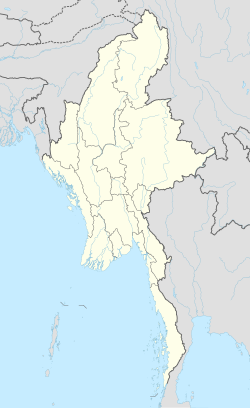


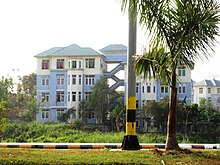
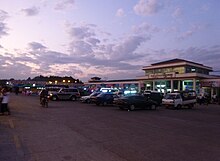
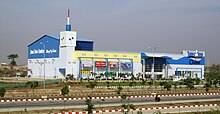




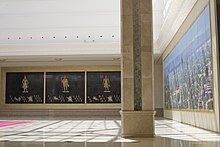
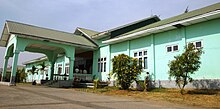

















Nice post, I bookmark your blog because I found very good information on your blog, Thanks for sharing- more information
ตอบลบLaparoscopic Surgery Treatment in Bangalore | 3D Laparoscopic Surgery in Bangalore| Laparoscopic Gynaecologist in Bangalore